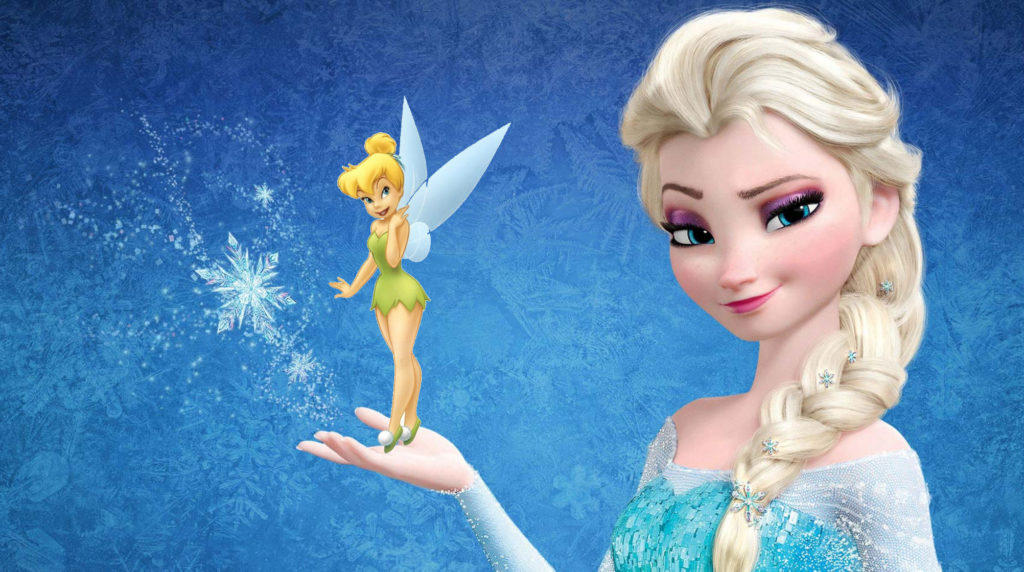The Disney Princess franchise has influenced the childhoods of millions of people today, both girls and boys. The franchise features some of the most iconic women of Disney films past and present and send a message that anyone can be like all the women in the Disney Princess lineup.
However, not all female characters in Disney films end up in the official lineup of Disney princesses – yes, even those who are officially princesses in their own movies. Here’s a complete explanation on the Disney Princess franchise, why some characters are official members of the franchise and others aren’t, why Tinker Bell was taken out of the official roster, and what it really means to be a Disney Princess.
What Is the Disney Princess Franchise?
The idea for the Disney Princess Franchise began when, in the late 1990s, Andy Mooney noticed young girls attending a Disney on Ice show wearing princess costumes that were non-authentic Disney merchandise. As part of The Walt Disney Company’s Disney Consumer Products division, he knew their department could use the fact that little girls were trying to project themselves as Disney princesses and use it to improve sales.
Mooney and his team would then go on to plan a franchise for Disney princesses. This would create merchandise like princess costumes that followed Disney standards, have Disney licenses, and the right colors matching their characters. When they pitched this idea in January 2000, Roy E. Disney was against the idea of the Disney Princess franchise because he didn’t like the idea of taking princesses out of their fairy tales and grouped together, as he thought it would weaken the original stories they were from.
However, by the early 2000s, the Disney Princess franchise was launched and several products including dolls, costumes, pets, and comic figures were sold. Oddly enough, Mooney did not use any focus groups or marketing strategies, but in 2001, they had generated 300 million dollars in product sales. By 2012, Disney increased their revenue to three billion dollars.
Not all female Disney characters are part of this franchise, though. Most of the “official” Disney Princesses are given a coronation to celebrate their induction to the Disney Princess franchise. The only exception to this is Moana, who was added to the roster in 2019 without having a coronation. Heroines and popular Disney female characters who aren’t officially part of this list are labelled “unofficial” Disney Princesses.
The Disney Princesses were featured in animated series, print, films, games, audio, and other Disney merchandise. You can find most of the Disney Princesses roaming around Disneyland around the Fantasyland area or roaming near Cinderella’s Castle.

Photograph Courtesy: Disney
The Official Disney Princesses
The original line-up of princess when the franchise launched included nine princesses. In 2005, Tinker Bell was taken out of the roster. After that year, Disney released several princess movies that were successful and decided to add more princesses to the official list. As of 2019, this is the official list of Disney Princesses:
- Snow White – The first Disney princess created. Born into royalty.
- Cinderella – Married into royalty.
- Aurora – Born into and married into royalty.
- Ariel – The first non-human princess. Born and married into royalty.
- Belle – The first princess who independently tries to be a heroine. Married into royalty.
- Jasmine – The first person-of-color princess and the first princess who wasn’t the main character of the film. Born into royalty.
- Pocahontas – First Native American princess. Born into royalty.
- Mulan – First member of the roster who was not born into royalty or married into one. However, the success of her film, her role as a heroine, and her Asian roots make her an honorary princess in the list.
- Tiana – Added in 2010 after her coronation at the New York Palace. First Black American princess. Married into royalty.
- Rapunzel – Added in 2011 after her coronation in Kensington Palace. Born into royalty.
- Merida – Added in 2013 after her coronation at Walt Disney World. First Pixar princess. Born into royalty.
- Moana – Added in 2019 but was not given a coronation ceremony. First Polynesian princess. Born into royalty.
Criteria to Qualify as a Disney Princess
Not all princesses are considered an official Disney Princess, though. While Disney has not released an official criteria as to what makes a female character fall under the Disney franchise, fans have found that the five rules must stand for a character to enter the franchise:
- The character must be born a female human or be a magical creature with human-like aspects. Ariel is a mermaid and Tinker Bell is a fairy, but both were part of the official roster because they resembled human women.
- The character must be a main character or at least have a significant role in a Disney or Pixar film. Princess Jasmine was not the titular main character in the film Aladdin, but she was a main character and played a significant role in the movie.
- The character must be introduced in the first film of the series, not the film’s succeeding sequels. This rule cancels out Princess Melody (Ariel’s daughter) from The Little Mermaid II and Princesses Ting-Ting, Su, and Mei from Mulan II from becoming a part of the list.
- The character must be born or married into a royal family or whatever ruling family system exists in their film. Moana and Pocahontas, for example, are daughters of the chief of their tribe. If they do neither, they must at least perform a feat of heroism worthy of praise from a royal person and the people. Mulan was not born into royalty nor did she marry a royal person, but she saved China and was praised by the Emperor of China.
- The film the character starred in must do successfully financially. If they belong to an underwhelming (Princess Eilonwy) or extremely successful (Princess Anna and Queen Elsa) films, they are excluded. The film must also be culturally relevant and is suitable for young audiences.
The Unofficial Disney Princesses
Female characters that do not meet all these criteria but are technically still princesses or set themselves apart as heroines in Disney films are labelled “Unofficial Princesses.” They may be seen in some Disney Princess products and promotions (like how Princess Anna and Queen Elsa had a cameo in Wreck-It-Ralph 2), but these characters are not part of the official franchise:
- Minnie Mouse
- Daisy Duck – both Minnie and Daisy have been portrayed as princesses in several Mickey Mouse franchise movies and TV series. The Mickey Mouse franchise is financially successful on its own, hence there is no need to add these two into the Disney Princess roster.
- Alice – Alice in Wonderland was not as successful relative to all the other Disney films during its time.
- Tinker Bell (Peter Pan) – formerly classified as a Disney Princess but was later removed.
- Maid Marian (Robin Hood) – Film was not popular enough.
- Princess Eilonwy (The Black Cauldron) – Film was not popular and financially successful.
- Queen Nala (The Lion King) – Did not have a significant role in the film.
- Esmeralda (The Hunchback of Notre Dame) – The film has scenes and themes not suitable for children.
- Megara (Hercules) – Was not born/married into royalty and was an anti-hero who initially worked for the film’s villain.
- Princess Dot & Princess Atta (A Bug’s Life) – Non-human characters who did not have significant roles in their movie.
- Jane Porter (Tarzan) – Not born/married into royalty.
- Jessie (Toy Story 2) – Introduced in a sequel.
- Princess Melody (The Little Mermaid II) – Introduced in a sequel.
- Empress Kida (Atlantis) – Not a financially successful and popular movie.
- Ting-Ting, Su, and Mei (Mulan II) – Introduced in a sequel. Did not have a significant role.
- Giselle (Enchanted) – Was not born/married into royalty.
- Nancy (Enchanted) – Married into royalty, but did not have a significant role.
- Vanellope von Schweetz (Wreck-It-Ralph) – Film was successful in its own and did not require Vanellope to join the Disney Princess roster.
- Princess Sofia (Sofia the First) – TV series; not as popular as other Disney films.
- Princess Anna and Queen Elsa (Frozen) – Frozen was extremely successful and managed to exceed sales expectations. Thus, they managed to be independent from the Disney Princess franchise.
- Princess Elena (Elena of Avalor) – TV series; not as popular as other Disney films.
Tinker Bell: Why Was She Removed?
In 2005, Tinker Bell was removed from the official line-up because Disney wanted her to headline a new sister franchise called Disney Fairies. Around this time, Winx Club (a TV show about fairies studying to harness their powers and fight villains) and W.I.T.C.H. (a TV show about five girls with magic) were gaining popularity and creating franchises of their own, and Disney wanted to create their own franchise to compete in this niche.
On the site of Pin Up online https://ps3hits.su gambling club is worth registering at least for the wide selection of exciting games for all tastes. In the casino Pin Up you can play for money in slots, roulette, poker, blackjack, games with live dealers, etc. And winnings can be quickly and easily withdrawn to a credit card (Visa, MasterCard) or e-wallet (Google pay, Sistema, IBox, Easy Pay2Click).
Tinker Bell was originally considered a princess, but while everyone else on the list could adhere to the five unofficial rules of being a Disney Princess, Tinker Bell was a non-human who could only communicate through non-verbal actions, was neither born or married into royalty, and did not have a significant role in the original Peter Pan film. Mooney decided she did not fit into the Princess mythology and was taken out of the list when they decided she could instead head her own franchise as a Disney fairy.
Disney Fairies was created in 2005. Tinker Bell became the head mascot while several new fairies in Never Land were introduced. The first film, Tinker Bell, was released in 2008 and explored the fairy world of Never Land and how Tinker Bell had grown to be the fairy everyone met in Peter Pan.
Instead of Fantasyland, you can find Tinker Bell and the other fairies in the franchise roaming around Pixie Hollow as of 2008.
The fact that some of our favorite Disney female characters can expand and create their own franchise shows how whimsical and diverse the world of Disney films and TV shows are. And with more Disney Princesses and other characters in the near future, we can expect the official list of princesses to expand or a whole new franchise to start.




